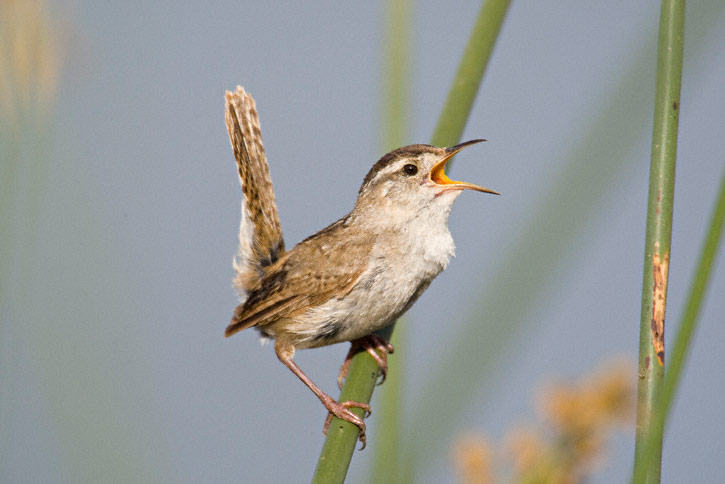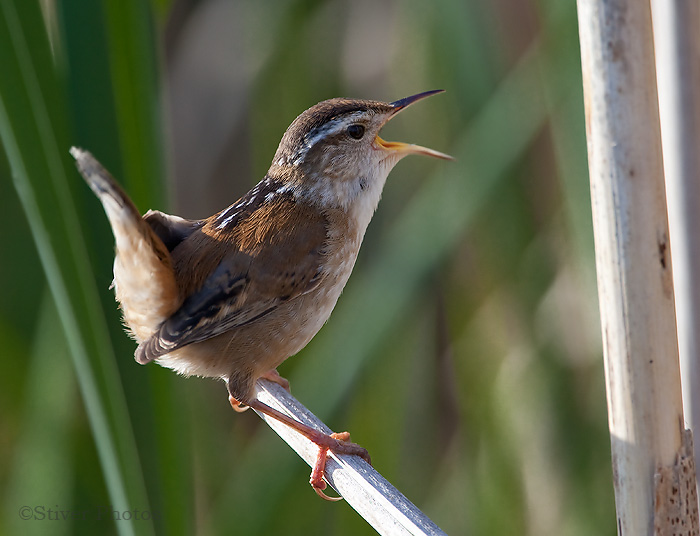
Cistothorus palustris
TAXONOMY
Certhia palustris Wilson, 1810, eastern Pennsylvania. 15 subspecies
recognized.
OTHER COMMON NAMES
English: Long-billed marsh wren; French: Troglodyte de
marais; German: Sumpfzaunkцnig; Spanish; Saltapared Pantaсero.
PHYSICAL CHARACTERISTICS
4.5–5 in (11.5–12.5 cm). Male 0.43–0.5 oz, mean 0.45 oz
(12.1–14 g, mean 12.7 g). Populations in western North America
weigh slightly less. Crown is blackish brown; back is
medium-brown with broad collar of blackish; streaked white on
upper back. Wings and tail are reddish brown with darker bars.
Supercilium is whitish, contrasting with cap and brown eyestripe
and ear-coverts. Underparts are gray, becoming buff on
lower belly and flanks. Eyes are brown; bill is dark brown
above and yellowish brown below; legs are pale brown. Sexes
are identical. The juvenile rather duller than an adult with reduced
white streaking on back; supercilium is less obvious.
DISTRIBUTION
Breeds across North America from New Brunswick and Virginia
to British Columbia, north to northern Alberta, south to
central Midwestern states and California; also coastal marshes
along the eastern United States seaboard and Gulf of Mexico.
Populations in eastern and western North America may be two
distinct species.
HABITAT
Freshwater marshes with cattails, bulrushes, or phragmites;
coastal marshes with Spartina. Winter migrants occur frequently
in coastal brackish marshes.
BEHAVIOR
Active and noisy, moving rapidly among reeds, often clinging
spread-eagled to two separate stems. The bird is highly territorial
and predatory on eggs, both of its own species and of others,
such as red-winged blackbirds. Song is a characteristic
metallic rattle, sometimes uttered at night. There are many
distinctive patterns of songs, with major differences between
eastern and western populations.
FEEDING ECOLOGY AND DIET
Food is mainly invertebrate, including beetles, bugs, dragonfly
larvae, spiders, etc. Predated eggs may be partially eaten. Feeds
from the water level to the tops of reeds, but usually stays
fairly low.
REPRODUCTIVE BIOLOGY
Exhibits two features found in many other wren species to a
high degree, multiple nest-building and polygamy. The nest is
a domed structure with a side entrance usually about 3 ft (1 m)
above water level. It is made of strips of leaves and grass and
lined with down. Eggs number three to 10, usually four to six,
fewer in southern populations. They are brown with darker
speckles, rarely white. Incubation is by the female, for 13–16
days; young fledge in 13–15 days. Rate of polygamy varies
among different populations; may be more than 50% in central
Canada, with a significant number of trigamists.
CONSERVATION STATUS
Not threatened. Can be common in suitable habitat. Can reach
high densities of up to 75 males per acre (190 per ha) in prime
HABITAT
. Much habitat loss is due to swamp drainage; conversely,
recent water impoundments may create habitat.
SIGNIFICANCE TO HUMANS
Has been and continues to be an intense object of research because
of its complex song patterns and interesting breeding
BEHAVIOR
.
Photo Gallery of - Marsh wren




 Animalia Life
Animalia Life